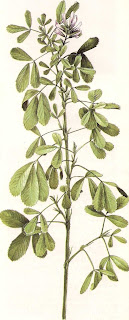Medicago saliva L. Buffalo Herb, Lucerne, Purple Medic
PEA FAMILY
Leguminosae

An important forage and hay crop, sweet-smelling alfalfa originated as a wild legume, presumably in the dry uplands of western Asia. The Medes of ancient Persia are thought to have been the first to domesticate the plant, hence its Latin name, Medicago sativa, which means "sowed by the Medians." The plant reached Mediterranean Europe by way of the Greeks, who planted it as early as 490 B.C. It pleased the Arabs so well that they dubbed it al-fasfasah, "the best fodder." Not only did they feed the leaves, sprouts, and seeds to their horses to give the animals superior speed and strength, but they considered it excellent food for themselves, too. In Spain the Arabic word al-fasfasah became alfalfa.
Ultimately, alfalfa reached the New World with the Spanish Conquistadores, who planted it in Mexico and Chile. California setders, calling the novelty Chilean clover, began grow¬ing it as fodder in the mid-1800's, and it has been a significant American crop ever since.
Although there is no scientific evidence that alfalfa alters the course of any disorder, herbal¬ists prescribe alfalfa tea and alfalfa tablets, for example, for a variety of complaints, from diabe¬tes to alcoholism to tooth decay. But alfalfa does have a future in human nutrition, particularly as an inexpensive source of vitamins C, D, E, and K.
Habitat: Can be cultivated almost everywhere, even in dry regions. Naturalized varieties spring up along roadsides, in abandoned fields and lots, and in low valleys.
Range: Introduced from Europe, alfalfa has been naturalized in most of North America, especially in the West.
Identification: A bushy perennial 1-3 feet tall. The leaves are alternate and pinnately divided, with three dark green leaflets that are toothed toward the tips. Purple to yellowish flowers (May-October) arranged in heads produce twisted pods containing seeds in the fall.



